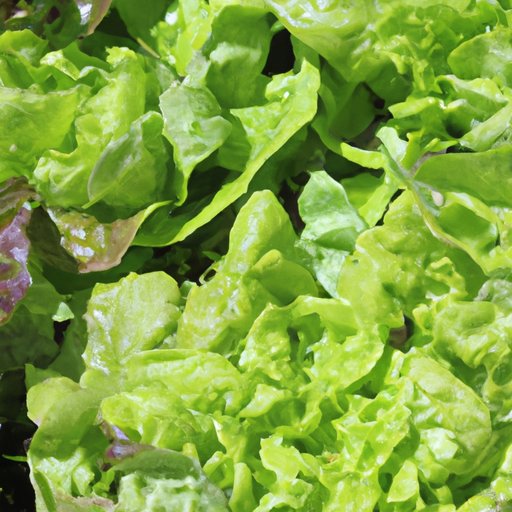I. Introduction
Are you tired of growing lettuce only to find that it doesn’t perform as well as it should? The answer to a successful lettuce harvest might just be companion planting. Companion planting is a technique that involves growing plants together that provide mutual benefits. In this article, we will discuss the benefits of companion planting with lettuce, what grows well with lettuce, and how companion planting can improve your overall garden health
II. Companion Planting
Companion planting is not a new method of gardening. Gardeners have been using this technique for centuries to mitigate pest problems, reduce diseases, and improve the overall health and yield of their crops. When it comes to growing lettuce, certain companion plants can provide various benefits such as pest management, soil improvement, and overall growth.
Companion planting with lettuce and carrots is beneficial for both plants. Carrots can improve soil conditions by breaking up soil compaction, while lettuce provides shade for young carrots and attracts pollinators. Radishes are another compatible companion plant for lettuce. Radishes are fast-growing and can help loosen soil, which benefits lettuce roots. Additionally, radishes can repel pests such as cucumber beetles and squash bugs, which can be destructive to lettuce. Herbs such as cilantro, dill and chives can attract beneficial insects that prey on lettuce pests while boosting the growth of the plant in general.
III. Container Gardening
Lettuce is an ideal crop for container gardening, as it requires minimal space and can thrive in partial shade. When it comes to companion planting for lettuce in containers, creative possibilities abound. Consider planting lettuce with complimentary plants such as spinach, kale, and chard, which tolerate shade and grow well in containers. Additionally, planting lettuce next to marigolds, chives, and basil can deter pests and improve soil quality. Container gardening also has the additional benefit of being able to move plants around to regulate sun exposure, temperature, and manage pests.
IV. Succession Planting
Succession planting is the act of planting crops with staggered growing periods in the same space to maximize the productivity of your garden. This is particularly useful for lettuce, which can have a short growing season. Planting faster-growing crops such as radishes or spinach along with the lettuce can help to maximize the productivity of the space. This provides an additional crop harvest while squeezing the most out of your gardening area over a given season. Be sure to use planting techniques that will not inhibit the growth of any long-term crops you may have planted in the space.
V. Climate Considerations
Choosing the right companion plants for lettuce requires ensuring that they are compatible with the climate in your area. For example, in warmer climates, there is a risk of bolting from lettuce plants. Therefore, the inclusion of other companion plants at this time can act to provide shade, preventing the lettuce from bolting prematurely. In colder climates, lettuce can be grown with cold-tolerant plants such as kale, broccoli, or leafy greens. To cope with frost, using companion plants such as frost-tolerant pansies will help to extend the growing season during colder months.
VI. Pest Control
Pest control is a major concern for gardeners, and companion planting can play a part in keeping pests at bay. Certain companion plants can act as natural repellents or attract beneficial insects that prey on pests. Plants such as marigolds and nasturtiums can be planted next to lettuce to naturally repel pests or attract predator insects that will feed on yours. Additionally, herbs such as cilantro can help to drive away aphids and spider mites, while chives and dill can deter aphids, root maggots, and slugs.
VII. Culinary Pairings
Growing companion plants with lettuce not only helps to ensure a healthy garden but can also provide flavorful combinations in the kitchen. Combining lettuce with herbs such as dill, basil, or tarragon can enhance the flavor of salads, while other compatible vegetables such as radishes, beets, and carrots provide additional variety. Consider pairing lettuce with fruits like strawberries and pears to get a juicier texture and a sweeter taste. Add beetroot or even some chicken or steak slices and you got yourself a full-sized dinner!
VIII. Conclusion
Companion planting offers a range of benefits for gardeners, from reducing pests to improving soil quality. Pairing compatible companion plants with lettuce, such as carrots, radishes, and herbs, can provide mutual benefits that lead to successful and healthy growth. Using container gardening and succession planting techniques can also help maximize garden space and productivity, while adapting to climate considerations and engaging in natural pest control measures.
(Note: Is this article not meeting your expectations? Do you have knowledge or insights to share? Unlock new opportunities and expand your reach by joining our authors team. Click Registration to join us and share your expertise with our readers.)
